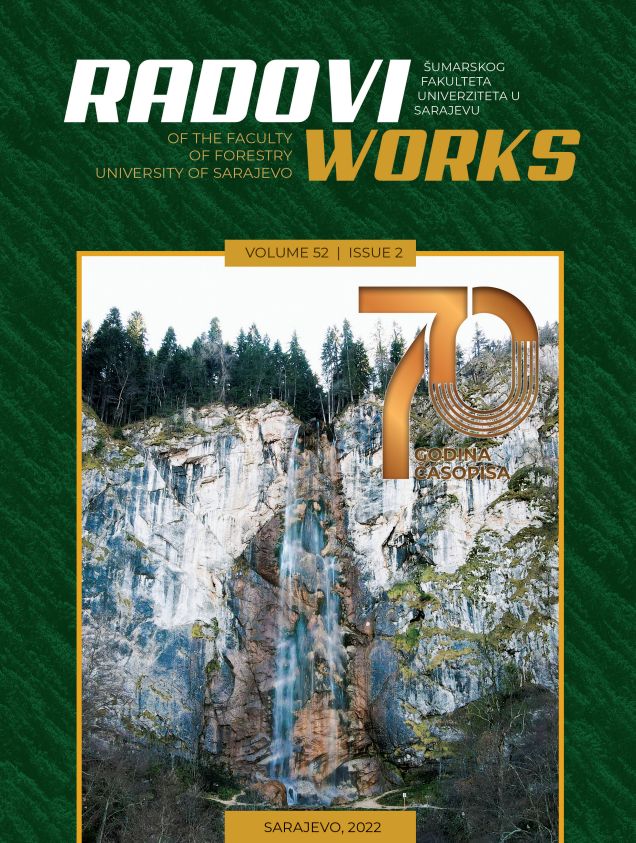The influence of the structural pattern of the scots pine (Pinus sylvestris L.) stand on the water regime of the limestone soils in south-western Bosnia and Herzegovina
DOI:
https://doi.org/10.54652/rsf.2022.v52.i2.378Abstract
The forest plays an important role in regulating the water regime, i.e., preventing the occurrence of torrential floods, which depends on the type of trees that make up the stand, the canopy, age, and the structure of the stand. This paper examines the influence of the structural characteristics of the stand on the water regime, using the example of the plantation of scots pine (Pinus sylvestris L.) on limestone in south-western Bosnia. An experimental plot (50x50m) was defined and surveyed in the subject plantation. Additionally, rain gauges were installed in different conditions of the canopy, with which the amount of precipitation that reaches the surface of the forest ground was determined. Rain gauges were also placed on an open area close to the plantation. Research has shown that with an increase in the number of trees per hectare and a higher canopy of the stand, the retention of rainwater in the tree crowns increases by up to 30%. In a stand of scots pine, 720 trees per hectare were found, while for the optimal interception, that number should be around 1,400. However, an increase in the number of trees within the stand can have a negative impact on the stability of the stand. With a larger number of trees within the stand, the competition is greater, the trees dry out, the slenderness of the trees is higher, and the trees break or fall. A 40-year-old stand of scots pine has formed a forest litter on the surface of the ground, which has an absolute dry mass more than 4 times greater than the mass of dry matter of the grass cover on the open surface. Research has shown that in a closed stand of scots pine, a smaller amount of precipitation reaches the ground, but forest soils have a better ability to infiltrate, retain and evenly distribute water over a longer period of time. Silvicultural operations in the stand can achieve the same interception effect with a smaller number of trees per unit area if better development of tree crowns is encouraged.
Downloads
References
Beus, V. (2005). Šume regulator vodnog režima i zaštite zemljišta od erozije. Upravljanje rizicima od poplava i ublažavanje njihovih štetnih posljedica. Akademija nauka i umjetnosti BiH, Sarajevo
Hodžić, A. (2022). Značaj šumskih kultura bijelog bora u regulaciji vodnih režima na krečnjacima u jugozapadnoj Bosni. Master rad. Univerzitet u Beogradu. Šumarski fakultet. Erozija zemljišta i prevencija bujičnih poplava.
Jevtić, M. (1992). Nega četinarskih kultura sastojina veštačkog porekla proredom. Prosilva, Beograd.
Klein, B., Irrgang, S. (2003). Mit dem Wald gegen die Flut. Landesforstpräsidium (LFP). OT Grupa. S. 44.
Lojo, A., Balić, B., Bajrić, M., Alojz, Đ., Hočevar, M., (2008). Druga državna inventura šuma u Bosni i Hercegovini – komparacija rezultata prve i druge inventure šuma za oblast 1. Šumarski fakultet Univerziteta u Sarajevu
Mekić, F. (1998). Uzgajanje šuma, ekološki osnovi. Šumarski fakultet Univerziteta u Sarajevu.
Nainar, A., Tanaka, N., Sato, T., Mizuuchi Y., Kuraji K. (2021). A comparison of hydrological characteristics between a cypress and mixed-broadleaf forest: Implication on water resource and floods. Journal of Hydrology, Volume 595. s. 1-14.
Neary, D.G., Ice, G.G., Jackson, C.R., (2009). Linkages between forest soils and water quality and quantity. For. Ecol. Manag. 258, 2269–2281. https://doi.org/10.1016/j.foreco. 2009.05.027.
Perzl F. (2018). Schützt der Wald vor Naturgefahren. Bundesforschungs- und Ausbildungszentrum für Wald, Naturgefahren und Landschaft (BFW).
Pintarić, K. (1991). Uzgajanje šuma, II - dio tehnika obnove i njege sastojina. Šumarski fakultet Univerziteta u Sarajevu
Pintarić, K. (2004). Značaj šume za čovjeka i životnu sredinu, Udruženje šumarskih inženjera i tehničara Federacije Bosne i Hercegovine, Sarajevo.
Roehrig, E., Bartsch, N., von Luepke, B. (2006). Waldbau auf oekologischer Grundlage. 7 Auflage. Ulmer verlag. S. 479.
Stratford, C., Miller, J., House, A., Old, G., Acreman, M., Dueñas-Lopez, M. A., Nisbet, T., Newman, J., Burgess-Gamble, L., Chappell, N., Clarke, S., Leeson, L., Monbiot, G., Paterson, J., Robinson, M., Rogers, M. and Tickner, D. (2017). Do trees in UK-relevant river catchments influence fluvial flood peaks? Centre for Ecology and Hydrology Wallingford, Oxfordshire, OX10 8BB, UK. S 45.
Strategija i akcioni plan za zaštitu biološke raznolikosti Bosne i Hercegovine 2015.-2020., Podrška Bosni i Hercegovini za revidiranje Strategije i akcionog plana za zaštitu biološke raznolikosti i izradu Petog nacionalnog izvještaja prema Konvenciji o biološkoj raznolikosti, NBSAP BiH, 2016.
Stojanović, Lj., Krstić, M. (2008). Gajenje šuma 1 - metodi prirodnog obnavljanja i negovanja šuma. Univerzitet u Beogradu – Šumarski fakulteta. Planeta print, Beograd.
Šumsko gospodarska osnova za ŠGP Livanjsko, 2022., nacrt
Unkašević, M. (2004). Šumarska Ekoklimatologija. Univerzitet u Beogradu - Šumarski fakultet. Planeta print, Beograd, S. 231.
Višnjić, Ć. (2006). Auforstung von sommertrocknenen Standorten mit heimischen Baumarten in BiH. Disertation. GA Universitaet Goettingen. Couvilier Verlag. S 166.
Xiao, L., Robinson, M., O´Conor, M. (2022). Woodland´s role in natural management: Evidence from catchment studies in Britain and Irland. Science of the Total Environment 813 (151877).
Downloads
Published
How to Cite
Issue
Section
License
Copyright (c) 2022 Adnan Hodžić, Ćemal Višnjić, Muhamed Bajrić, Mirjana Todosijević

This work is licensed under a Creative Commons Attribution 4.0 International License.






















